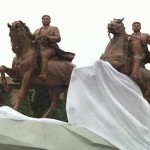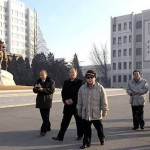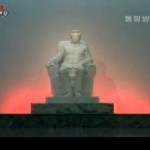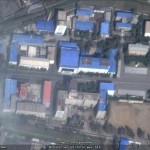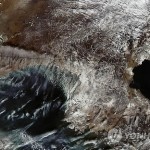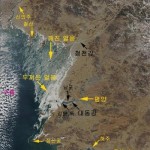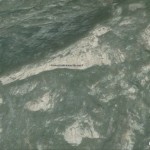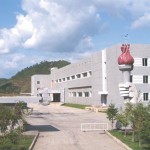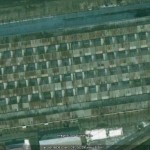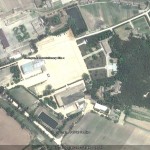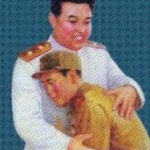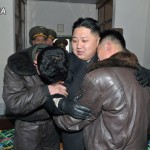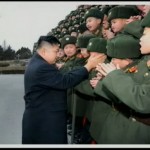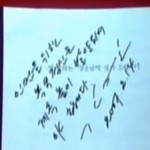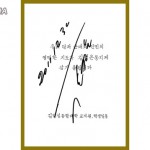Following the unveiling of the Kim Jong-il memorial carved into Mt. Sokda last week, today KCNA announced the unveiling of a Kim Il-sung and a Kim Jong-il statue at the Mansudae Art Studio in Pyongyang.
Click image for a larger version.
You can watch the unveiling in video format on the KCNA page here. You can watch the video on YouTube here.
According ot KCNA:
The statues of President Kim Il Sung and leader Kim Jong Il riding on horses together were erected at the Mansudae Art Studio with approach of the Day of the Shining Star.
Their construction, the first of its kind in the history of the Workers’ Party of Korea and the Korean revolution, is a great glory and pride of Kim Il Sung’s nation and Kim Jong Il’s Korea.
A ceremony of unveiling the statues took place on Tuesday.
Present there were senior party, state and army officials Kim Yong Nam, Choe Yong Rim, Ri Yong Ho, Kim Yong Chun, Kim Ki Nam, Choe Thae Bok, Yang Hyong Sop and Kang Sok Ju, officials of party, military and power bodies, social organizations, ministries and national institutions, men and
officers of the Korean People’s Army and the Korean People’s Internal Security Forces, officials and employees of the Studio and working people in the city of Pyongyang.
Senior officials of the party, state and army and officials of the studio unveiled the statues.
Laid at the statues is a floral basket from Kim Jong Un, supreme leader of the WPK and the people and KPA supreme commander.
Placed were floral baskets in the name of the WPK Central Committee, the Presidium of the DPRK Supreme People’s Assembly, the DPRK Cabinet, the Ministry of the People’s Armed Forces, the Ministry of People’s Security, working people’s organizations, ministries and national institutions,
units of the KPA and party and power organs in the city.The participants made bows to the statues.
Kim Yong Nam, member of the Presidium of the Political Bureau of the C.C., the WPK and president of the Presidium of the SPA, made an address at the ceremony.
It was the unanimous desire and ardent wish of all the Party members, servicepersons and people to erect a statue of Kim Jong Il as well as Kim Il Sung’s in order to hand down for all ages the prominent traits and revolutionary feats of the illustrious great man, the speaker said, adding:
This ardent desire has been realized thanks to Kim Jong Un’s boundlessly noble loyalty and meticulous guidance.
He called for glorifying the revolutionary careers and undying feats of Kim Il Sung and Kim Jong Il forever with the immutable faith that they are always with us.
The participants looked round the statues after being briefed on them.
Though the unveiling displayed BOTH Kim Il-sung and Kim Jong-il statues, there was previously a Kim Il-sung statue located at this exact spot. I am not sure if this statue has been decommissioned, moved, or incorporated into the new sculpture:
This is only the third Kim Jong-il statue of which I am aware–and the first located outside.
There is a Kim Jong-il statue at the International Friendship Exhibition in Myohyangsan:
The other Kim Jong-il statue is in the Ministry of the Peoples’ Armed Forces:
Both the Kim Il-sung statue and the Kim Jong-il statues were manufactured on location at the Mansudae Art Studio:
Pictured above (Google Earth): The Mansudae Art Studio in Pyongyang. The blue roofs indicate that most of the buildings have recently been renovated.
At the same time, the Daily NK reports that Kim Jong-un has asked that the costs of memorializing his father not be passed on the people (like this).
UPDATES related to the celebrations of Kim Jong-il’s 70th birthday:
1. Kim Jong-il also named “Generalissimo” — a title previously reserved for his father, Kim Il-sung. This clears the way for Kim Jong-un to be promoted to “Marshal”. Many officers were also promoted and awarded the Kim Jong-il Prize. Daily NK coverage here.
2. Commemorative gold and silver coins were issued to celebrate Kim jong-il’s 70th birthday. See more here and here.
4. A military tribute was held in Kumsusan Palace (which was renamed Kumsuan Palace of the Sun). See video here.
5. The KCNA web page added a Kim Jong-il photo album. See it here.
6. A new Kim Jong-il badge is issued.
7. NK Leadership Watch coverage here.
8. Here is my lengthy collection of material published when Kim Jong-il passed away.
